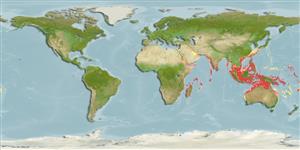Environment: milieu / climate zone / depth range / distribution range
Ecologia
marinhas demersal; intervalo de profundidade 18 - 92 m (Ref. 11441). Tropical
Indo-West Pacific: Persian Gulf through the eastern Indian Ocean to the East Indies.
Tamanho / Peso / Idade
Maturity: Lm ? range ? - ? cm
Max length : 14.0 cm TL macho/indeterminado; (Ref. 9797)
Espinhos dorsais (total) : 0; Raios dorsais (total) : 65 - 77; Espinhos anais: 0; Raios anais : 41 - 50. Ground color yellowish or yellowish brown; dorsal, anal and caudal fins paler than body with dark spots. Blind side whitish. Some anterior dorsal fin rays elongated in males, not in females, all rays except a few at posterior end of fin unbranched. Pectoral fin on eyed side with 11-13 rays, on blind side with 10-13 rays. Caudal fin with 13-14 branched rays and rounded margin.
Inhabits sand and mud bottoms (Ref. 9797). Frequently collected in areas near river mouths (Ref. 9797). Feeds on bottom-living animals (Ref. 9797). Mostly used in making fish meal but is also marketed fresh (Ref. 9797).
Ciclo de vida ou comportamento de acasalamento
Maturities | Reprodução | Spawnings | Egg(s) | Fecundities | Larvas
Kuronuma, K. and Y. Abe, 1986. Fishes of the Arabian Gulf. Kuwait Institute for Scientific Research, State of Kuwait, 356 p. (Ref. 5999)
Status na Lista Vermelha da UICN (Ref. 130435)
Ameaça para os humanos
Harmless
Uso pelos humanos
Pescarias: pouco comercial
Ferramentas
Relatórios especiais
Baixar XML
Fontes da internet
Estimates based on models
Preferred temperature (Ref.
123201): 23.7 - 28.6, mean 27.5 °C (based on 661 cells).
Índice de diversidade filogenética (Ref.
82804): PD
50 = 1.0156 [Uniqueness, from 0.5 = low to 2.0 = high].
Bayesian length-weight: a=0.01122 (0.00514 - 0.02450), b=3.04 (2.87 - 3.21), in cm total length, based on all LWR estimates for this body shape (Ref.
93245).
Nível Trófico (Ref.
69278): 3.5 ±0.37 se; based on food items.
Resiliência (Ref.
120179): Elevada, tempo mínimo de duplicação da população menor que 15 meses (Preliminary K or Fecundity.).
Fishing Vulnerability (Ref.
59153): Low vulnerability (10 of 100).
